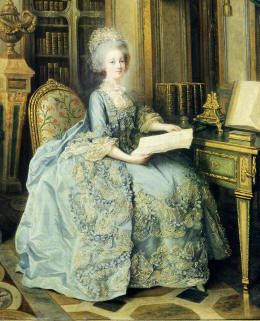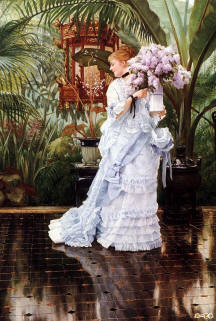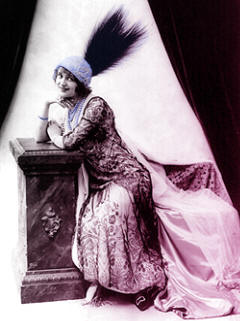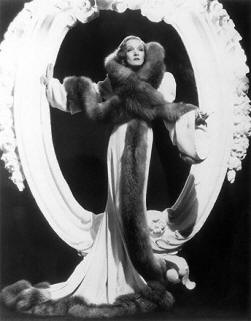|
|
|
|
This page is dedicated
to gowns and garments from different eras in
history. Please click on the photos below to see
more from the eras that interest you. If you have
any questions at all, please don't hesitate to email me. No
question is silly or insignificant. Please do ask
about whatever is on your mind whether it be about a
custom order or just curiosity. I would love to help
with anything you might wonder about.
Saloon Girls and Burlesque outfits can be found
under the Victorian era |
|

Dauphine at Versailles
by
L. L. Périn-Salbreux |
|
Baroque/Rococo/Georgian
1600 - 1830
These periods kind of
overlap each other and
also depend on country
and field of arts.
Typical fashion colors
were pale, with
variations from pale
pinks and silvery blues
to brilliant reds and
dark blues which was
very popular for some
time with indigo coming
from India. In general,
pastel colors were the
most popular.
Wealthy women wore
richly decorated gowns.
Wide hoops supported
elaborately embroidered
and trimmed skirts.
Hairdos grew to new
heights. Hair was draped
over wire cages, rolled
into large locks and
decorated with flowers,
feathers, artificial
birds with nests and
even miniature ships.
|
|
| |
|
|
|
|

Caroline (Bonaparte)
Murat & daughter Letizia
by Elisabeth Vigée-Lebrun |
|
Regency 1795 -
1820 (1837)
The high waist Empire
dresses of the early 19th
century were usually
made in fine white lawn,
muslin, or batiste. White
gowns were a sign of
social status as white
soiled easily, these
were generally used for
evening, and pastel or
colored robes were more
suitable for day
wear. Heavy velvets,
cottons, linens, fine
wools, and silks were
used in winter. The
decorations were Greek
art inspired. Greek key
patterns decorated
borders, garment hems,
and sleeve bands.
The Napoleonic Wars
introduced military
style details such as
frogging, braids, cords,
and other trims,
featured on clothing for
both men and women.
The latter years of the
Regency period were influenced
by the Middle Ages. By
1820, the dress had lost
all classical form and
took on a pure Gothic
line which lasted until
Queen Victoria's
ascension. |
|
| |
|
|
|
|

Bunch of Lilacs
by James Tissot |
|
Victorian Era 1837-1901
Early Victorian 1837 -
1956
Crinoline 1856 - 1869
Early Bustle 1870 -
1876
Natural Form 1877 - 1882
Late Bustle 1883 - 1889
Belle Epoch 1890 - 1901
Saloon Girls/Burlesque
In the Victorian era,
fashion begins to change
far more rapidly than it
had in the past. The
most overt manifestation
of this accelerated
tempo of change is the
constant shifting of the
fashionable silhouette
of women's dress,
evolving shapes of
skirts, sleeves, and
bodices. |
|
| |
|
|
|
|
 |
|
Edwardian 1901 -
1918
The Edwardian period is
often extended beyond
Edward's death in 1910
to include the years up
to the sinking of the
RMS Titanic in 1912, the
start of WW I in 1914,
or to the end of the war
in 1918.
The
upper classes
embraced leisure sports,
which led to rapid
developments in fashion,
as more mobile and
flexible clothing
styles were needed. The
very tight corset,
or bodice, was modified,
and later its everyday
wearing was gradually
abandoned.
|
|
| |
|
|
|
|

Marlene Dietrich by
Travis Banton, 1935 |
|
1920 - Present
This category will
contain dresses from
1920 to the present.
Please take a look at
what is available and if
there is any style dress
you don't see but would
love to have made,
please don't hesitate to
email me and I am sure
we can work together to
make your dream
gown/garment a reality. |
|
| |
|
|
|
|
eeeee
w
fffff
All images, graphics, and text on this
website are copyright to Christine
Hall Designs and are not to be
copied for personal or business use.
All movie
and art images on this site are the
property of their respective owners and are for
reference purposes only. I am not affiliated
with any of these entities. |
|